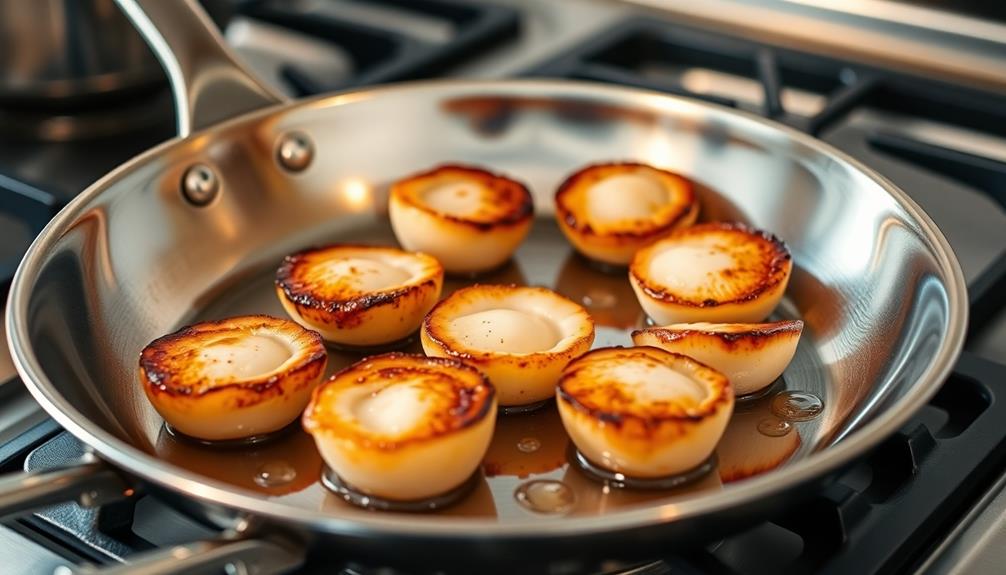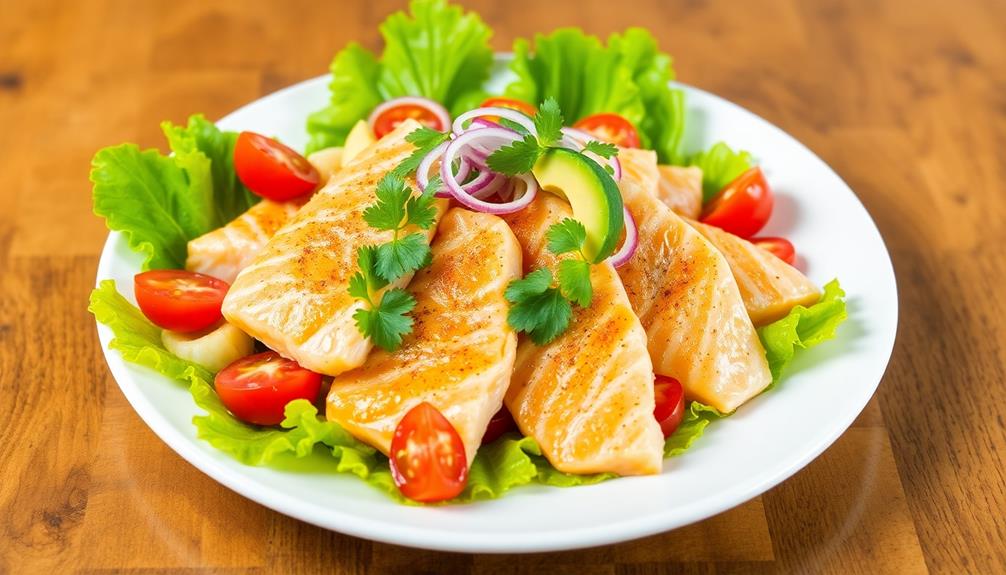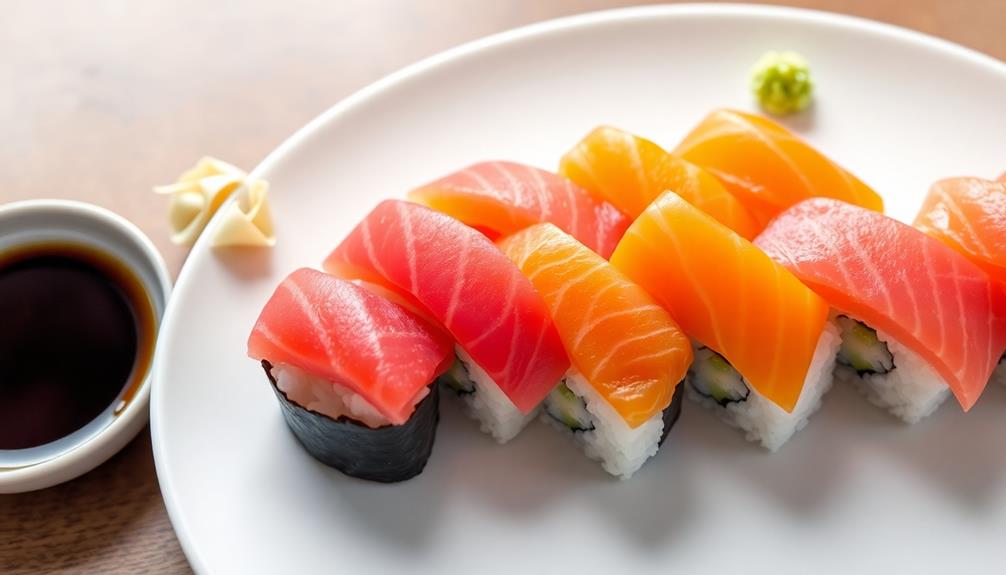Perfectly seared scallops are the hallmark of culinary excellence, and you can master this restaurant-quality technique at home. Start by selecting dry-packed scallops – they sear better than their wet-packed counterparts. Pat the scallops thoroughly dry, then lightly coat them in high-smoke point oil. Heat a heavy skillet until scorching hot and add the scallops, letting them sizzle undisturbed for 2-3 minutes to develop a golden-brown crust. Flip them and continue cooking until the centers are opaque. Serve immediately for a delightful contrast of crispy exterior and tender, juicy interior. Exciting flavor possibilities await as you explore the art of searing scallops.
Key Takeaways
- Choose dry-packed scallops for superior flavor and texture compared to wet-packed scallops.
- Pat scallops thoroughly dry and sear in a hot, heavy-bottomed skillet to achieve a golden-brown crust.
- Cook scallops undisturbed for 2-3 minutes per side to develop a perfect sear.
- Serve seared scallops immediately for the best texture and flavor contrast.
- Experiment with diverse seasoning blends and complementary sauces to enhance the scallops' natural sweetness.
History
Tracing the origins of perfectly seared scallops, you'll find that this delectable dish has captivated seafood enthusiasts for centuries. From the ancient coastal civilizations of Asia and Europe to the modern-day kitchens of renowned chefs, the art of searing scallops has evolved, becoming a symbol of culinary excellence. One popular way of enjoying perfectly seared scallops is in a Provençal fisherman’s stew, where the delicate flavors of the scallops enhance the rich broth. The dish has become a staple in upscale seafood restaurants, where chefs compete to create the most succulent and flavorful seared scallops. It’s no wonder why this centuries-old dish continues to be a favorite among food lovers around the world.
Scallops, with their succulent, sweet, and tender meat, have long been prized for their versatility and exceptional flavor. As early as the 15th century, European cooks began experimenting with various techniques to achieve the perfect sear, unlocking the scallop's natural sweetness and creating a crisp, golden-brown exterior.
Over time, the method of searing scallops has been refined, with chefs and home cooks alike honing their skills to achieve that coveted restaurant-quality result.
Today, the perfectly seared scallop is a hallmark of fine dining, a testament to the timeless allure of this marine delicacy and the enduring pursuit of culinary perfection.
Recipe
Seared scallops are a delightful and elegant dish that can be enjoyed as an appetizer or a main course. The key to perfectly seared scallops is to start with high-quality, fresh seafood and to follow a few simple techniques to achieve that golden-brown crust and tender, juicy interior.
When it comes to selecting scallops, look for dry-packed, "dry" scallops, as they'll sear better than wet-packed ones. Dry-packed scallops are typically a bit more expensive, but the difference in flavor and texture is well worth it.
- 1 pound large, dry-packed sea scallops
- 2 tablespoons unsalted butter
- 1 tablespoon olive oil
- Salt and freshly ground black pepper
Pat the scallops dry with paper towels and season them generously with salt and pepper. Heat a large, heavy-bottomed skillet over high heat until it's smoking hot. Add the butter and olive oil, and swirl to coat the pan.
Carefully add the scallops, making sure not to overcrowd the pan. Sear the scallops for 2-3 minutes per side, or until they develop a beautiful golden-brown crust.
The key to perfectly seared scallops is to avoid moving them too much during the cooking process. Let them develop that delicious caramelized crust before flipping.
Serve the scallops immediately, and enjoy the contrast of the tender, juicy interior and the crisp, flavorful exterior.
Cooking Steps
First, make sure to pat those scallops dry with a paper towel – you want them as dry as possible before cooking.
Next, give them a light coating of oil so they'll sear up beautifully in the hot skillet.
Once your skillet is ripping hot, gently add the scallops and let them sizzle until they're golden-brown on the outside. Yum!
Step 1. Pat Scallops Thoroughly Dry
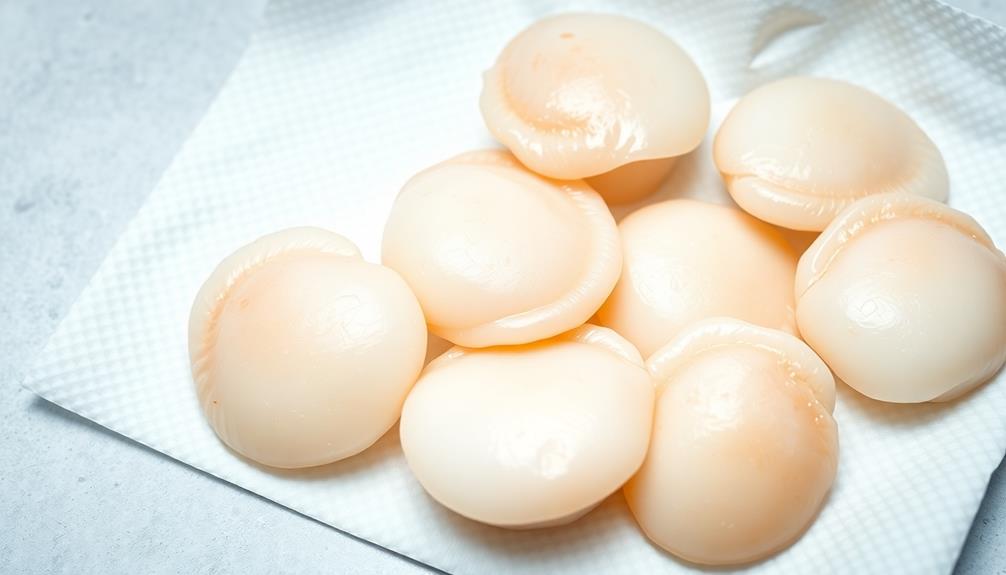
Oftentimes, it's crucial to pat the scallops thoroughly dry before searing them. This simple step is the key to achieving that perfect golden-brown crust we all crave. Gently blot the scallops with paper towels, making sure to remove any excess moisture. This will help the scallops caramelize beautifully when they hit the hot pan.
Properly drying the scallops is essential because excess moisture will cause the scallops to steam rather than sear. The goal is to get a nice, crisp exterior while keeping the interior tender and succulent. Take your time with this step – you want to make sure each scallop is completely dry before moving on to the next stage of the cooking process.
Once the scallops are thoroughly patted dry, you're ready to start searing them to perfection. This simple prep work will make all the difference in the final result, giving you that restaurant-quality sear you've been dreaming of.
Get ready to impress your family and friends with your scallop-searing skills!
Step 2. Coat Scallops With Oil
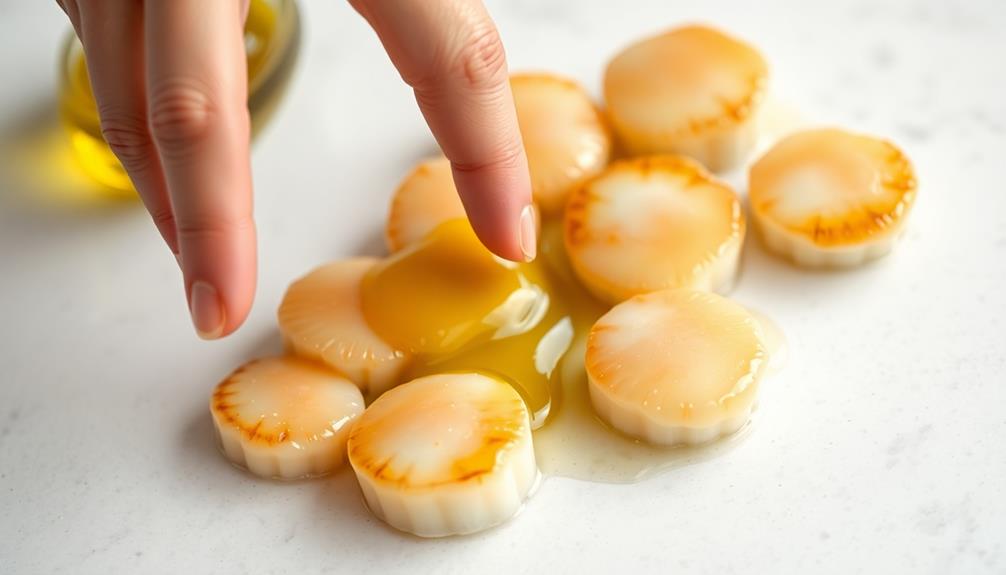
After thoroughly drying the scallops, you'll want to lightly coat them in oil. This helps create a beautiful sear on the outside while keeping the inside tender and juicy.
You can use any high-smoke point oil like vegetable, canola, or grapeseed oil. Just pour a small amount into your pan and use your fingers or a brush to evenly coat each scallop. Be sure not to over-oil them, as too much can prevent that perfect sear.
The key is a thin, even coating that will help the scallops get nice and crispy when they hit the hot pan. Once they're all oiled up, you're ready to start searing!
The oil will help the scallops brown beautifully and develop that delicious caramelized flavor we all love. Just remember to work in batches if necessary to avoid overcrowding the pan.
With perfectly seared scallops, you're well on your way to a restaurant-quality meal at home.
Step 3. Heat Skillet Over High

With your scallops evenly coated, you'll want to heat a large, heavy-bottomed skillet over high heat.
This high heat is crucial for getting that perfect sear on your scallops. You'll want to let the pan get ripping hot, which might take a couple of minutes.
To check if it's ready, carefully hold your hand a few inches above the pan – you should feel intense heat radiating upwards.
Once the pan's ready, it's time to add your scallops. Arrange them in a single layer, making sure they've got plenty of space between them.
This will prevent them from steaming instead of searing. Let the scallops cook for 2-3 minutes, until you see a nice golden-brown crust developing on the bottom.
Resist the urge to move them around too much – you want that sear to happen!
When the time's up, flip the scallops and let them sear on the other side for another 2 minutes or so.
Perfectly seared scallops, coming right up!
Step 4. Add Scallops to Hot Skillet
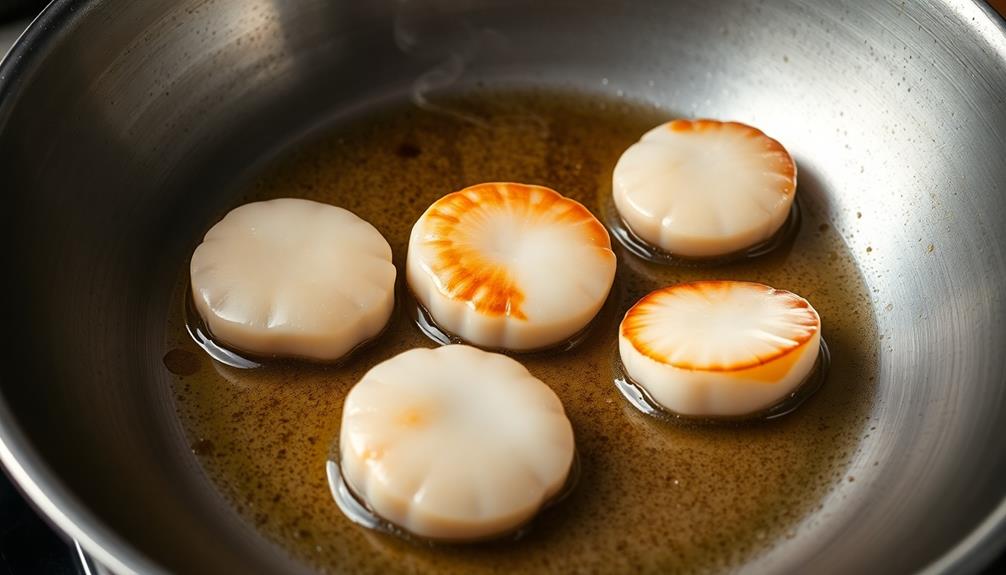
Once the pan is scorching hot, go ahead and add your scallops. Be careful as they'll start to sizzle immediately! Gently place each scallop in the pan, making sure they've a little space in between.
Don't overcrowd the pan, or they won't get that delicious sear. Let the scallops cook for about 2 to 3 minutes on the first side. You'll know they're ready to flip when they release easily from the pan and have a gorgeous golden-brown crust.
Flip the scallops over and cook for another 2 to 3 minutes on the other side. Keep a close eye on them, as scallops can go from perfectly cooked to overcooked in a flash.
You want them to be opaque all the way through but still tender and juicy in the center. Once they're done, transfer the seared scallops to a plate and repeat with any remaining scallops.
Get ready for the most mouthwatering, restaurant-quality scallops you've ever tasted!
Step 5. Cook Until Golden-Brown
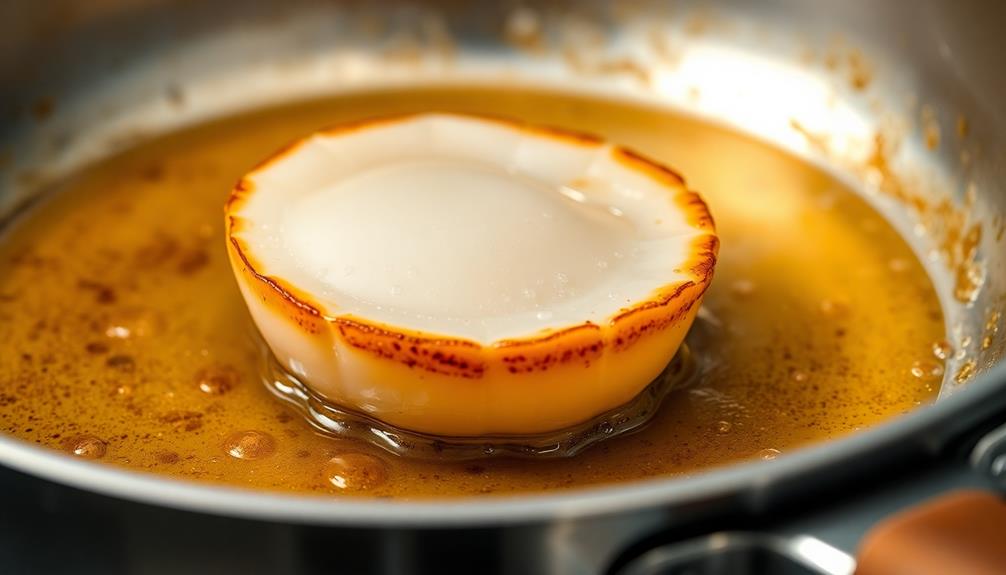
At this point, you'll want to cook the scallops until they develop a gorgeous golden-brown crust. This is the key to achieving that perfect sear and restaurant-quality texture.
Make sure the skillet is ripping hot before adding the scallops. They should sizzle loudly when they hit the pan. Don't overcrowd the skillet – cook the scallops in a single layer with a bit of space between them. This allows the heat to circulate and ensures even browning.
Keep a close eye on the scallops and resist the urge to move them around. Let them cook undisturbed for 2-3 minutes. When they're ready, the scallops will release easily from the pan with a gentle nudge of your tongs.
Flip them over and cook for another 2 minutes on the other side. You're looking for a rich, caramelized crust all around. Once they're perfectly seared, transfer the scallops to a plate and get ready for the final step.
Final Thoughts
Searing scallops to perfection is an immensely gratifying culinary experience. You've mastered the art of achieving that coveted golden-brown crust, and now you can proudly serve up restaurant-quality scallops in your own kitchen.
The key is to trust your instincts and let the scallops sear undisturbed, resisting the urge to fidget. Remember, patience is a virtue when it comes to achieving that perfect sear.
Don't be afraid to experiment with different seasoning blends and flavor profiles. The versatility of scallops makes them a blank canvas for your culinary creativity.
Try pairing them with vibrant sauces, fresh herbs, or a sprinkle of lemon zest to elevate the dish. And don't forget to savor every bite – the combination of the sweet, tender scallops and the satisfying crunch of the sear is simply divine.
With these tips in mind, you're well on your way to becoming a scallop-searing master. Enjoy the process, and bon appétit!
Frequently Asked Questions
What Type of Scallops Are Best for Searing?
For the best seared scallops, you'll want to use dry, fresh sea scallops. They have a firmer texture and will caramelize beautifully when seared at high heat. Avoid wet scallops, which can steam and result in a less crisp exterior.
How Do I Ensure the Scallops Don't Stick to the Pan?
To prevent scallops from sticking to the pan, make sure the pan is hot enough and use a bit of oil or butter. Ensure the scallops are patted dry before searing, and don't overcrowd the pan.
Can I Substitute Any Other Type of Seafood for Scallops?
Yes, you can substitute other types of seafood for scallops. Firm, delicate fish like cod, halibut, or tilapia would work well. Just adjust the cooking time as needed to avoid overcooking the seafood.
How Do I Reheat Seared Scallops Without Overcooking Them?
To reheat seared scallops without overcooking them, gently warm them in a skillet over low heat. Don't let the pan get too hot, and don't overcrowd the scallops. Flip them occasionally until they're just heated through.
What Side Dishes Pair Well With Perfectly Seared Scallops?
Perfectly seared scallops pair beautifully with a variety of side dishes. Consider serving them with roasted vegetables, creamy risotto, or a light salad to complement the delicate flavor and texture of the scallops.
